I belong to a small circle of good buddies who, like me, are into shooting military surplus rifles and other cool old guns. We get together every two months or so for an informal match at the West End Gun Club. It’s a fun match, nothing terribly formal, and the winner has to buy lunch for everyone (and it’s usually me or Greg shelling out the cash for the fine Mexican lunches that follow our get-togethers). Those events are a lot of fun and you can read about them (and the milsurp rifles) on our ExhaustNotes Tales of the Gun page.
Lots of times, though, it’s just me and good buddy Greg out there on the rifle range, and this past Friday morning was one of those days. When that happens, we’ll usually send an email around to the other guys in our milsurp squad talking about what we shot, the loads we used, and how we did. We did that last week, and I thought I’d share the emails with you. First, my email to the boys…
Guys:
Every once in a while I get this feeling I need to sell a few guns, and that happened again earlier this week. I thought one of the ones I would sell was a pristine Model 43 Winchester Deluxe in .22 Hornet. This rifle is in as new condition with the original bluing. It was manufactured in 1949, 2 years before I was born. I took it out of the safe with the idea of taking a few photos for Gunbroker.com, and then I realized: What was I thinking? I don’t want to sell this rifle. Nope, a far better idea would be to load some .22 Hornet ammo and take it to the range.

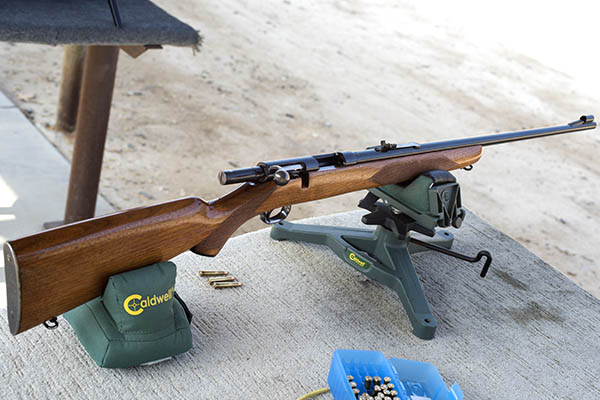
I bought the Model 43 about 6 years ago and until this morning I had never fired it. It found it on the consignment rack at Turner’s in Covina. After seeing the rifle there, I stopped by every other week for a couple of months, and then on one visit I saw they had dropped the price. I thought it was fairly priced at the original number they had on the rifle, but I was initially hesitant. It’s a beautiful rifle, but it didn’t really fit in with the other stuff in my modest collection and I didn’t want to shell out big bucks for another toy that would just sit in the safe. When they dropped the price, though, I pounced. The gun department manager there was mildly annoyed because he wanted to buy it and it a weird sort of way that made me feel good. Hey, you snooze, you lose.
I knew I had waited too long to finally get around to shooting the old Winchester, but the Hornet’s day in the sun was today. The Model 43 and I found our way to the WEGC range this morning, and as you might imagine, it was a good day. Hell, any day on the rifle range is a good day.
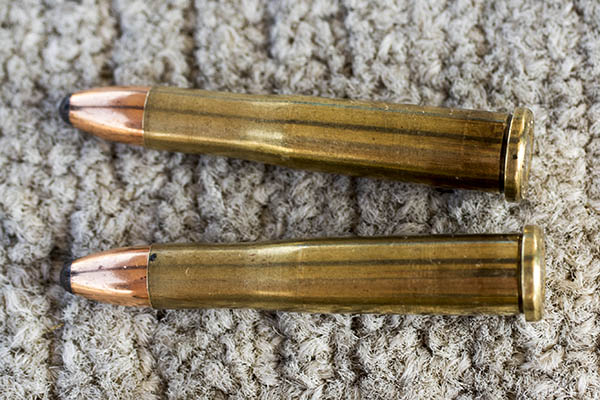
About that .22 Hornet ammo: Good buddy Michael B sent some Hornet brass to me a few months ago. I loaded the brass Michael sent to me yesterday with a mild 4227 load (the powder came from Paul) and a box of 45 grain Sierra bullets that have been on my reloading bench since God was a roadguard. (Thanks, Michael…I put your brass to good use!) Good buddy Greg was there with me. He can verify that everything you read here is true, unless he takes the 5th.
[Note for our blog readers…you’ve heard me talk about good buddy Paul, who was my next door neighbor when we were kids. So was Michael. He’s Paul’s little brother.]
Here are a few more shots of the Model 43…it is a beautiful little rifle. Clean, rare, collectible, and in fantastic condition. I mean, do any of you think you are going to look this good when you are 70 years old?
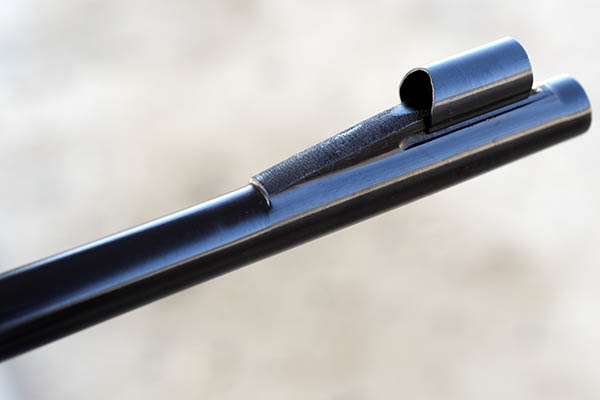
In examining the front sight and its ramp, I was surprised to see that it was a not a separate piece attached to the barrel. Nope, these barrels started as a giant hunk of steel, and were hogged down to shape. The front sight ramp is an integral part of the barrel. That had to be expensive to manufacture. Note the stippling on the ramp. Things were different in 1949.
I’m pretty sure that the bluing is original…the lettering and roll marks are all very crisp.
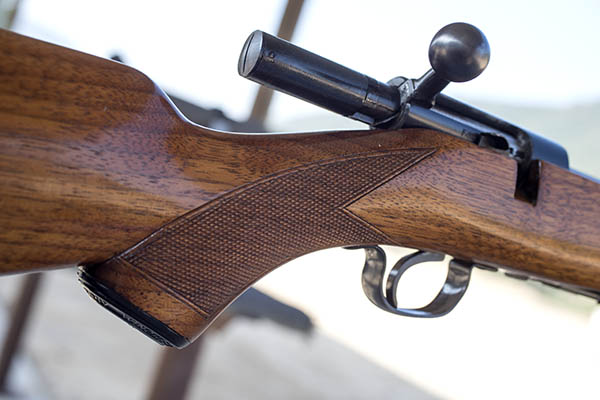
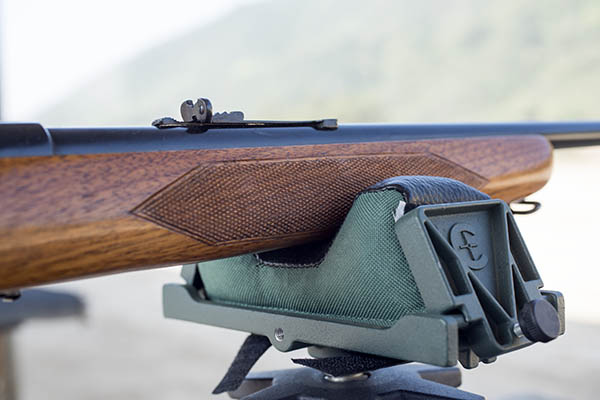
The stock may have been refinished, or at least had a coat or two or TruOil added to spruce it up somewhere along its life’s journey. The checkering is sharp, though. It might be the original stock finish. Overall, the rifle is in excellent condition.
And finally, a photo of Michael’s brass reloaded by yours truly in the original Model 43 magazine…I can’t imagine what a replacement magazine (if you could even find one) would cost for this rifle…
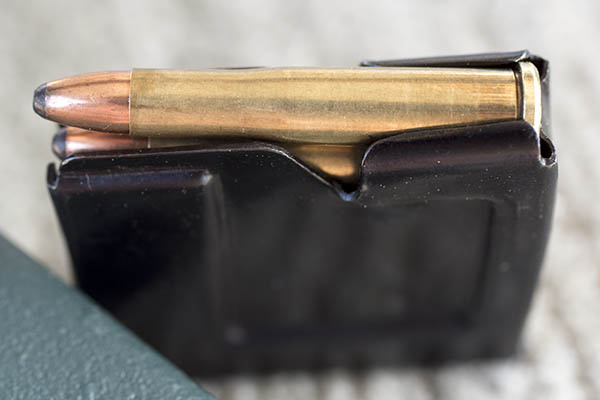
The Model 43 shot well this morning. It had already been zeroed in by the previous owner and it shot roughly 1-inch above point of aim at 50 yards, which is about perfect for a rifle like this. Recoil was very moderate, as you might imagine with a 45-grain bullet at 2400 fps. The groups were about 1.5 to 2.0 inches, which is, as they say, close enough for government work. Not too shabby for a 70-year-old Winchester.
Joe
So that was my email, and it was quickly followed by a response from Greg. Here’s what old Greg had to say…
Every word Joe says is true, I swear. That gun looked like someone just took it out of the box. And that machined ramp at the front sight was very unexpected. Anyone familiar with manufacturing techniques will immediately recognize the difficulty of machining that final few inches of the barrel. Eh, times gone by. You won’t find that on any guns today I think.
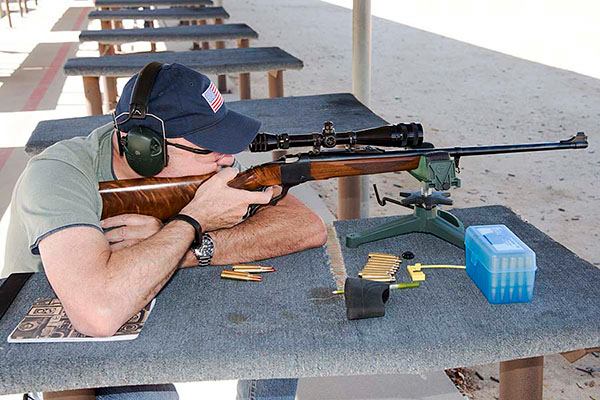
My story-of-the-day is the 7mm Remington Magnum Ruger No. 1 I took out. I had the normal power loads that did about as they usually do at 100 yards, roughly an inch and a half. But the surprise was a very low power load I jinned up with Trail boss. I had a 140 grain Sierra Game King sitting on top of 20 grains of Trail Boss (I know, it sounds weird). The Hodgdon site has a data sheet (attached) that has loads all the way up to a .416 Remington Magnum. But for the 140 grain bullet in a 7mm RemMag they list a load starting at 17.2 grains and going up to a max load of 24.5 grains, so my 20 grains was somewhere near the middle.
Anyway, I had just put away the Mini-14 and thought I’d start the Ruger No. 1 off with the low recoil Trail Boss loads. I was stunned to see the five shot group pictured below (at .685”). It was easily the best group of the day for the rifle, though it ended up on paper about 12” below, and 1” to the left, of the “normal” loads for that beast. Recoil was extremely mild as you would expect.
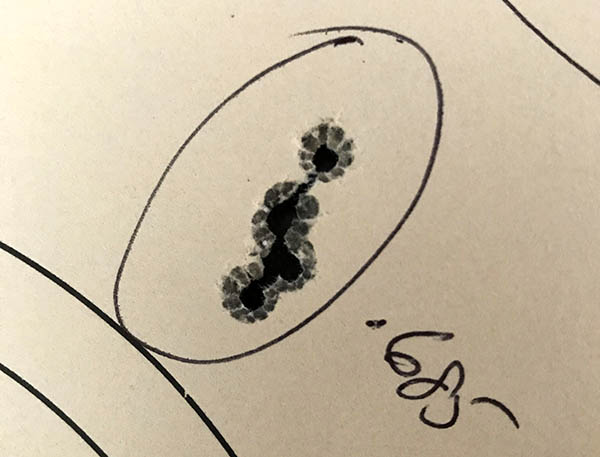
My problem with this Trail Boss load is that the scope, as mounted, doesn’t have the adjustment range to accommodate the 12” drop at 100 yards, so I may end up shimming its mount to enable the use of Trail Boss. Time will tell…
Greg
And there you have it. More good times, good guns, good shooting, and good loads. Stay tuned…because we’ll keep the Tales of the Gun stories coming!
